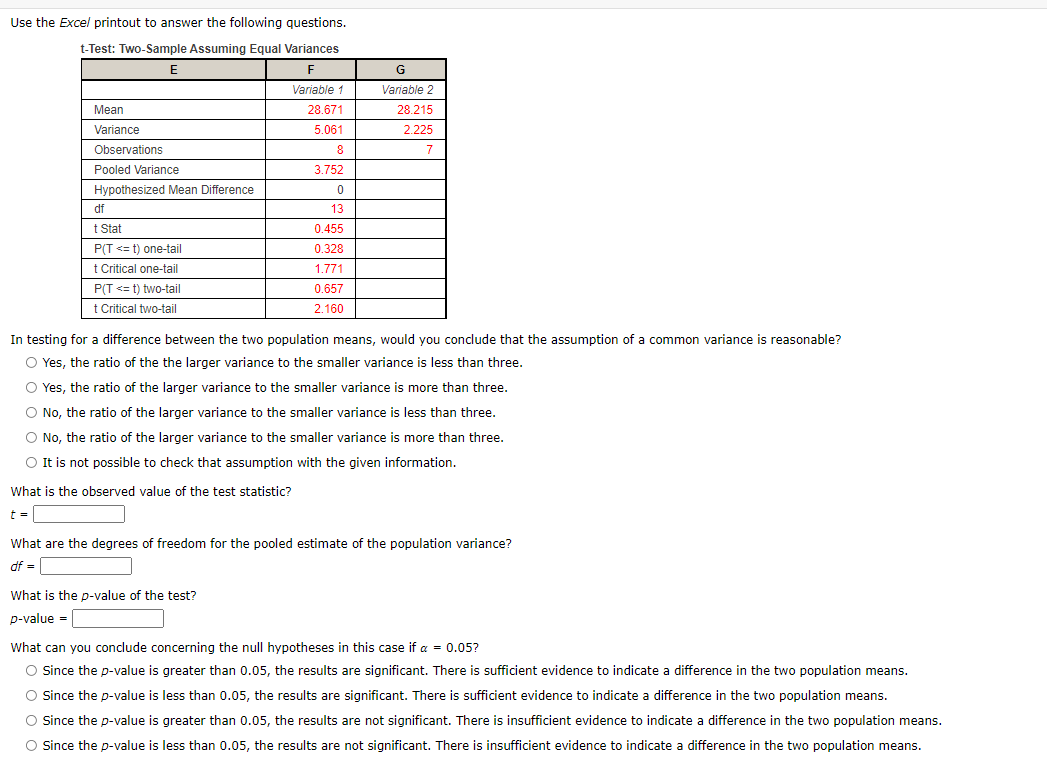In testing for a difference between the two population means, would you conclude that the assumption of a common variance is reasonable? Yes, the ratio of the the larger variance to the smaller variance is less than three. Yes, the ratio of the larger variance to the smaller variance is more than three. O No, the ratio of the larger variance to the smaller variance is less than three. O No, the ratio of the larger variance to the smaller variance is more than three. O tis not possible to check that assumption with the given information. What is the observed value of the test statistic? t = What are the degrees of freedom for the pooled estimate of the population variance? df = What is the p-value of the test? p-value What can you conclude concerning the null hypotheses in this case if a 0.05?
In testing for a difference between the two population means, would you conclude that the assumption of a common variance is reasonable? Yes, the ratio of the the larger variance to the smaller variance is less than three. Yes, the ratio of the larger variance to the smaller variance is more than three. O No, the ratio of the larger variance to the smaller variance is less than three. O No, the ratio of the larger variance to the smaller variance is more than three. O tis not possible to check that assumption with the given information. What is the observed value of the test statistic? t = What are the degrees of freedom for the pooled estimate of the population variance? df = What is the p-value of the test? p-value What can you conclude concerning the null hypotheses in this case if a 0.05?
Glencoe Algebra 1, Student Edition, 9780079039897, 0079039898, 2018
18th Edition
ISBN:9780079039897
Author:Carter
Publisher:Carter
Chapter10: Statistics
Section10.5: Comparing Sets Of Data
Problem 13PPS
Related questions
Question
100%

Transcribed Image Text:Use the Excel printout to answer the following questions.
t-Test: Two-Sample Assuming Equal Variances
E
Variable 1
Variable 2
Mean
28.671
28.215
Variance
5.061
2.225
Observations
8
7
Pooled Variance
3.752
Hypothesized Mean Difference
df
13
t Stat
0.455
P(T <= t) one-tail
0.328
t Critical one-tail
1.771
P(T <= t) two-tail
0.657
t Critical two-tail
2.160
In testing for a difference between the two population means, would you conclude that the assumption of a common variance is reasonable?
O Yes, the ratio of the the larger variance to the smaller variance is less than three.
O Yes, the ratio of the larger variance to the smaller variance is more than three.
O No, the ratio of the larger variance to the smaller variance is less than three.
O No, the ratio of the larger variance to the smaller variance is more than three.
O It is not possible to check that assumption with the given information.
What is the observed value of the test statistic?
t =
What are the degrees of freedom for the pooled estimate of the population variance?
df =
What is the p-value of the test?
p-value =
What can you conclude concerning the null hypotheses in this case if a = 0.05?
O Since the p-value is greater than 0.05, the results are significant. There is sufficient evidence to indicate a difference in the two population means.
O Since the p-value is less than 0.05, the results are significant. There is sufficient evidence to indicate a difference in the two population means.
O Since the p-value is greater than 0.05, the results are not significant. There is insufficient evidence to indicate a difference in the two population means.
O Since the p-value is less than 0.05, the results are not significant. There is insufficient evidence to indicate a difference in the two population means.
Expert Solution
This question has been solved!
Explore an expertly crafted, step-by-step solution for a thorough understanding of key concepts.
Step by step
Solved in 2 steps

Recommended textbooks for you

Glencoe Algebra 1, Student Edition, 9780079039897…
Algebra
ISBN:
9780079039897
Author:
Carter
Publisher:
McGraw Hill

Glencoe Algebra 1, Student Edition, 9780079039897…
Algebra
ISBN:
9780079039897
Author:
Carter
Publisher:
McGraw Hill